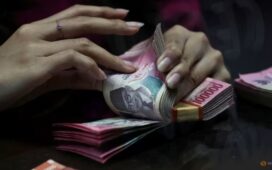Markets opened this morning like a gambler finding a lucky chip under the table — a flicker of optimism after three days of losing hands. The Fed’s soft cooing about “labor market weakness” was all traders needed to spin a rate-cut narrative into another round of risk-on roulette. Japan, South Korea, and Australia followed Wall Street’s late-night whisper higher, even as the backdrop remains one long corridor of creaking geopolitical pipes and leaky trade ceilings.
Let’s call it what it is — a one-day pop dressed up as a pivot. In the broader lens, the US–China trade war isn’t pausing for breath; it’s just reloading. The tariff cannons are still warm, and the next volley could get ugly. But the new battlefield may not be across the Pacific — it’s drifting toward Europe. Brussels now finds itself the collateral debris field of Washington’s tariff diplomacy, caught between economic overreach and strategic exposure. The EU, already creaking under its own debt scaffolding, is being inundated by a flood of cut-price Chinese goods — a harbor after a typhoon, where every incoming container threatens to sink another local manufacturer. The irony? Those same cheap exports, forged under the heat of US tariffs, are now the very waves crashing at Europe’s shores — the unintended consequences of someone else’s trade war washing up in the Old World’s front yard.
Meanwhile, the market mood feels like standing between two weather systems — one warm with Fed easing winds, the other cold with geopolitical squalls. Powell, playing the role of monetary meteorologist, confirmed what the market already priced: another quarter-point cut is coming in October. Swaps have pencilled in 125 bps of cuts by the end of next year — an entire dovish runway mapped before the plane has even left the gate.
But the market knows this choreography: Powell sighs, bonds rally, gold glows, and equities pretend it’s springtime again. Gold hovers near its peak, silver still recovering from its parabolic fireworks show — a squeeze so violent it briefly tore through $53.54 like a hot knife through bullion. Two-year yields have slumped to their lowest level since 2022, a sign that traders are rushing toward the safety of Fed cuts.
Oil, meanwhile, sulks near a five-month low, caught between weak demand signals and a dollar too tired to fight gravity. The greenback’s losses mirror trader psychology — wanting to believe in a softer Fed, but unable to fully divorce from global tension.
And that tension has plenty of new sequels. Trump, in his usual kitchen-table diplomacy, mused about “stopping cooking oil trade with China,” a bizarre but on-brand remark that sent algos blinking. Then came Beijing’s latest sanctions against US subsidiaries of a South Korean shipping group — another shot across the maritime bow as both sides flex for the next round of tech-trade brinkmanship.
Yet markets, in their eternal talent for self-deception, shrugged it all off as “posturing.” The coming South Korea trade meetings are being treated as a prelude to reconciliation — the equivalent of traders betting on a ceasefire because the soldiers paused to reload.
Europe, for its part, is flirting with a dangerous kind of industrial nationalism — now mulling forcing Chinese firms to hand over tech if they want to sell inside the bloc. It’s a bold move, but it risks looking like an economic Maginot Line: impressive on paper, easily outflanked in practice.
Over in Tokyo, political uncertainty thickens the air. The collapse of the ruling coalition has left Japan’s 20-year bond auction staring into a fog of risk. Sanae Takaichi’s surprise victory within the LDP briefly electrified the market — but the ensuing rupture of a 26-year alliance sent longer maturities tumbling and reintroduced that old Japanese specialty: uncertainty wrapped in bureaucracy.
And then there’s the AI trade — the market’s glittering totem of modern faith. According to the latest BofA survey, more than half of fund managers now call it a bubble. It’s as if traders, staring at the sun too long, finally realize it burns. The same investors who spent 2024 stuffing every portfolio corner with AI exposure now whisper about overvaluation and rotation — proof that even the gods of narrative eventually suffer fatigue.
So Asia opens today under the illusion of calm, a kind of market mirage where rate-cut euphoria and trade-war reality coexist in awkward harmony. For traders, this is a field day for short-term positioning — you ride the rebound, but keep your stop-loss finger ready. Because beneath this smooth surface, the volcano still rumbles.
The Yuan’s hidden blade — When devaluation becomes the quiet weapon of mass dislocation
Not my base case, but a hidden tail risk
When push finally comes to shove in this sprawling tariff war, the sharpest knife on the table isn’t a container fee or a rare earth embargo — it’s the Chinese Yuan. Beneath the noise of dockside politics and tariff theatrics, Beijing’s truest form of retaliation is far more elegant and infinitely more disruptive: quietly guiding the Yuan lower and letting the ripples do the heavy lifting.
Devaluation, after all, is the monetary version of asymmetric warfare — the kind of move that doesn’t need to shout. When China lets the currency slide, it doesn’t just tweak competitiveness; it destabilizes the global scaffolding built on the assumption that the world’s second-largest economy keeps its currency roughly anchored. The first thing to go isn’t the Yuan itself — it’s everything pegged, priced, or psychologically tied to it.
And yes, G-10 would also be dragged into the plunge tank.
When the Yuan moves, emerging markets don’t just flinch; they convulse. Central banks from Jakarta to Johannesburg are forced into the same old dance — selling U.S. Treasuries to defend their currencies, draining dollar liquidity, and inadvertently destabilizing the plumbing of the global financial system. It’s a familiar horror movie: Treasury yields rising not because of growth, but because collateral is being sacrificed to keep exchange rates from unraveling. It’s a mini-replay of March 2020 — not triggered by pandemic panic this time, but by policy panic.
That’s why the U.S. Treasury market is America’s Achilles heel in this saga. Beijing doesn’t need to threaten semiconductor supply or weaponize rare earths — all it needs is a subtle downward nudge in the Yuan, and global reserve managers start liquidating Treasuries to replenish dollar defenses. A few billion here, a few billion there, and suddenly the “safest asset in the world” starts behaving like an emerging-market bond on a bad day. The irony is exquisite: the fortress of global finance could be breached not by Beijing’s exporters, but by its central bank’s FX desk.
Meanwhile, the world’s fiscal sinners — France, Japan, the UK — stand half-naked in the crossfire. Their long-dated yields are already screaming distress, the statistical equivalent of being six standard deviations away from sanity. Japan’s 10y20y forward Z-score north of six isn’t just unusual — it’s absurd. France’s, at nearly three, signals similar indigestion. If China’s devaluation deepens, global yields could spike again as risk aversion surges and the dollar takes off — the most unholy of trinities. It would expose over-levered sovereigns like swimmers caught when the tide goes out. The next crisis won’t be about banks; it’ll be about governments waking up to the realization that the bond market no longer believes in them.
And then there are the Dollar pegs — the financial Maginot Lines of emerging markets. Argentina’s peso, already overvalued and waiting for the electoral guillotine, will find no mercy. Turkey’s Lira, half-controlled and half-ignored, will again test how long you can defy gravity with capital controls and wishful thinking. Pegs that were already strained by U.S. exceptionalism could snap entirely if the Yuan’s descent lifts the Dollar into an unnatural orbit. The irony: EMs clinging to stability may find their moorings cut by the very anchor they chose.
A Yuan devaluation, in this context, is not a single act — it’s a chain reaction. It compresses global liquidity, undermines fiscal credibility, and turns the Treasury market into a stress barometer. The moment China stops defending and starts allowing, the world’s financial weather shifts. It’s not the thunderclap of tariffs that breaks things — it’s the quiet drift of a currency that forces everyone else to react.
In the end, devaluation isn’t an admission of weakness; it’s a reminder that currency remains the ultimate weapon in a world addicted to leverage. And when the next round of tariff brinkmanship arrives, Beijing won’t need to storm the ports — it will simply reach for the oldest tool in its kit, the silent lever that turns global equilibrium into global unease: the controlled fall of the Yuan.




